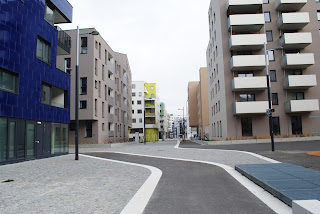Due to increasing complexity of
metros and large urban areas, the planning mechanism has perhaps not able to
resolve through mechanism of entrepreneurial market or mechanism of politics. The
planning commissions and functions seem to be insufficient to tackle the fundamental
issues of housing within metros and large urban areas. The planning without
empowered function in formal sense cannot be effective. Marx provided the
useful framework related to the planning functions of the city and issues related
at large with the society, where he contended that in truest form
of the man leads double life namely life of political community and life in
bourgeois society. The attempt to gain advantage in planning is to have welfare
of the individual within the community and society at large so that relationship
between two important functions becomes positive ones. The question of social
strategy and political feasibility to assess the changes in institutional framework
and ideas needs practical steps towards the handling of housing for large urban
areas. The context of such endeavor lies in changing nature of relationship that
individual has with the formal state and society.
Perhaps the housing in large
metropolis of Vienna has historically address this question and examined the relation of
individual and society as a nature of state, which represent the interest of bourgeois
and society. This attitude could prove useful to contemporary methods of
planning processes and development of individualistic ideas and institutional framework
in housing.
The Vienna housing records the trajectory
of imperatives that has caused such typological imagination. The Red Vienna
exhibition of housing (Nickname of the capital of Austria between 1918 and
1934. The Social Democrats had the majority and the city was democratically
governed for the first time). records the architects work in
housing with diverse typology attempting to address the housing issues of the
city.
The social housing was imagined
as a city within a city and was usually built as peripheral block developments:
a large gateway led into the often landscaped interior large open spaces, from
which the individual stairways and apartments were accessed. The housing were
built with regulated amenities such as swimming pools, supermarkets, Laundromats,
and kindergartens were frequently situated in the common buildings.
Another experiment that was
carried out was WERKBUND HOUSING. It is an experimental housing scheme in the
outskirts of Vienna originally constructed under the guidance of the architect Josef
Frank between 1930 and 1932. It was founded in Germany in 1907 the Deutscher Werkbund, or German Work Federation,
was an association of architects, designers, and industrialists interested in
modern architecture and industrial design, an influential group that later
became important in the creation of the Bauhaus school of design (Source . http://architectuul.com/architecture/werkbund-housing-vienna).
The aim was to achieve economy in the smallest space and functional solutions.
The experiments continue to
evolve around various experiments in large scale development or re-vitalization
of an existing neighborhood. The formation of Urban Renewal Cell is an attempt
to rejuvenate the existing housing stock with new addition and restoration.
RED VIENNA
WERKBUND ESTATE
URBAN RENEWAL PROJECT





























































No comments:
Post a Comment